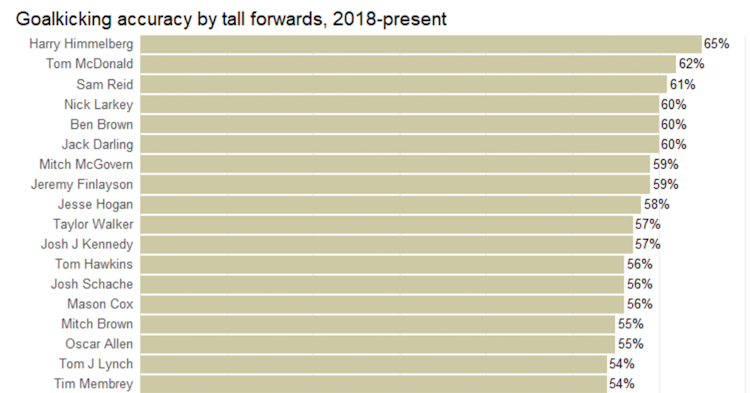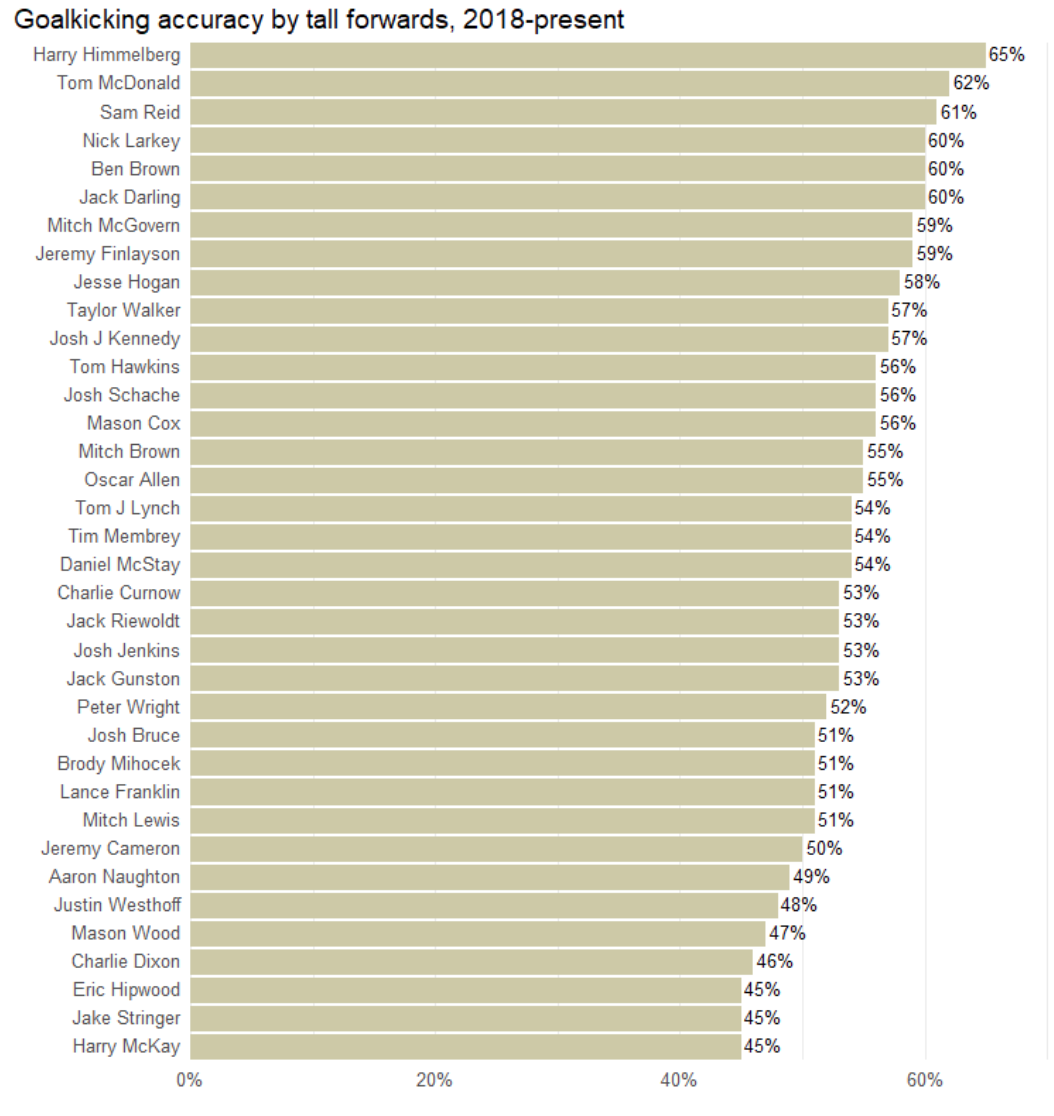Beyond the Goals: How AFL Key Forwards Compare Across Non-Traditional Metrics
Last updated: Jul 1, 2020, 7:49AM | Published: Jun 30, 2020, 4:49AM
Every year the AFL's Coleman Medal recognises the league's most prolific goal kicker – typically a 'key forward' (or tall forward) - come the end of the home-and-away season.
Yet, in recent seasons we are seeing more from key forwards beyond the scope of merely kicking goals.
So, where do the AFL’s best key forwards rank in these less-celebrated areas of the game?
Today we’ll compare 36 key forwards across the league using a variety of stats from 2018 through to the present.
Two qualifications get you on the books as a key forward for the purposes of this exercise. First, you must be 190cm in height, and second, you must have kicked at least 20 goals in either the 2018 or 2019 seasons.
Just one caveat – star Western Bulldogs midfielder, Marcus Bontempelli, does meet those conditions, but wasn’t included.
RELATED: Can the West Coast Eagles save their season?
WINNING THE CONTEST
 So, who is the AFL’s most dangerous on-on-one tall forward?
So, who is the AFL’s most dangerous on-on-one tall forward?
The chart above would suggest the surprising answer of Port Adelaide's Justin Westhoff, who wins an offensive one-on-one contest more than 42% of the time.
42% - less than half of all contests - may not seem like a lot at first glance, but it’s important to remember that these contests aren’t a binary between winning and losing – they are often drawn. The league-wide average for 190cm+ players in this stat is to win the contest 29.8% of the time.
Westhoff, a utility who sometimes plays a tall forward role rather than a bonafide key forward, is the only player in the top-eight here who engages in less than two offensive contests per game.
The other players on the podium - Geelong's Tom Hawkins and Sydney superstar, Lance Franklin - are names we’re more likely to conjure up than Westhoff when we think about the nightmare forward match-ups of the AFL. Adelaide's Taylor Walker and new-Cat recruit, Josh Jenkins round out the top five.
RELATED: Stats Insider's Updated Player Ratings
AT THE HIGHEST POINT
It’s often said that a lack of contested marking ability is one of the few flaws in Lance Franklin’s game, yet the stats don’t necessarily support that – ‘Buddy’s’ average of 1.96 contested marks per game since 2018 is the fourth highest of any key forward.
The three players above him are Collingwood's ruck-forward, Mason Cox, West Coast Eagle, Jack Darling, and Gold Coast Sun-turned-Tiger, Tom J Lynch, but for those who are excited to see the contested marking beasts of the future, it’s worth noting that Hawthorn's Mitch Lewis, Carlton's Harry McKay and Western Bulldogs' high-flyer, Aaron Naughton all feature in the top-ten.
Tom Hawkins’ 2.5 marks on the lead per game is the AFL’s best, with Franklin and GWS Giant Jeremy Cameron joining him in a star-studded top three. Carlton’s young duo of McKay and Charlie Curnow are both in the top ten for this stat.
Collingwood's Mason Cox is the player most dependent on contested marking ability to make his bread, with 49 per cent of his marks being contested, while Hawkins takes 41% of his marks on the lead - the most of any player in the league.
RELATED: Are the Navy Blues ready to be a force again?
BELOW THE KNEES
The ability to mark the ball - and in doing so create a set shot opportunity - is arguably the most traditional key forward skill – but being good below the knees and winning the ball at ground level adds another dimension to a key forward’s game.
In terms of raw ground-ball gets, it’s those tall's who spend the most time playing in other areas of the ground that do well – the likes of Fremantle's Jesse Hogan, Essendon's Jake Stringer and Westhoff all arguably get more opportunity here because of the specific roles they play.
However if we only factor in ground-ball gets recorded within the forward 50 zone, the Dockers' Hogan is still No.1 for key forwards with two per game. Hawkins, and GWS pair Harry Himmelberg and Jeremy Cameron, are his closest competitors.
'SHARPSHOOTERS'

Goalkicking accuracy never ceases to be a topic of discussion in the AFL, and if there’s a more fundamental skill for key forwards than the ability to mark the ball, surely the ability to put it through the middle sticks has to be it.
As per Stats Insider’s shot-charting tool – which has given us a much wider insight into this area of the game since it was released last year – the most accurate key forward is perhaps the unheralded name of Harry Himmelberg, with 65% accuracy.
If we were to measure it instead in terms of who has added the most points to their team’s tally beyond the expected score, former Crow captain Taylor Walker’s +84.9 is the best in the league, narrowly ahead of Lance Franklin (+83.3) and North Melbourne's Ben Brown (+76.3).
Kangaroo Nick Larkey (68%) and Demon Mitch Brown (66%) are the AFL’s most accurate big men when it comes to set shots, while Himmelberg (67%) again and Darling (66%) are the most reliable taking a shot out of general play.
RELATED: What has the Stats Insider Shot-Chart Explorer taught us in 2020 so far?
UNSELFISH
It’s one thing to kick a goal yourself, and quite another to bring a teammate into the game. And when it comes to unselfish forward-line play, Tom Hawkins takes the cake by two different measures.
Hawkins is the only key forward in the league who averages at least one goal-assist per game. Unsurprisingly, he’s no.1 for raw total of goal-assists over the time period measured, joined in the top-five by Harry Himmelberg and a trio of Jacks – Hawthorn's Gunston, Eagle Darling and Richmond's Riewoldt.
The score involvement stat, by itself, is a difficult one to analyse for key forwards – as kicking a goal (or behind) is of course a score involvement in itself.
But, if we subtract scoring shots from score involvements – let’s call them ‘unselfish score involvements’ – we can get a better picture of who’s doing the most to create scoring opportunities for others.
Hawkins leads this count too with an average of 3.9 per game. Joining him the in top five – Hogan, Himmelberg, Gunston and Westhoff, once again.
'BRINGING THE HEAT'
 Many teams place a specific focus on locking the ball inside forward 50 in the modern game, and
the ability to play on defensive pressure is something even attacking players are now expected to possess.
Many teams place a specific focus on locking the ball inside forward 50 in the modern game, and
the ability to play on defensive pressure is something even attacking players are now expected to possess.
The Bombers' Jake Stringer leads all comers for pressure acts, and while his quasi-midfield role might seem to explain this, he is still the No.1 when it comes to pressure acts in the forward half of the ground.
Still, that’s a stat that will include plenty of action going on outside the 50 metre arc. When it comes instead to the tackles inside 50 stat, Sydney’s Sam Reid stands above the rest with 1.4 per game.
Riewoldt, Hawkins, Darling and another Port Adelaide big man, Charlie Dixon, round out the top five in that stat, and alongside the Eagles' Josh J Kennedy and Geelong's Jenkins are the only keyforwards averaging more than one tackle inside 50 per game.
RELATED: Stats That Matter: The Tactical Evolution of AFL
'SWINGMEN'
For those with a fondness for seeing players swing back and forth between defence and attack, sadly, it just doesn’t happen that much in the modern game.
Only seven of our tall forwards has participated in at least 10 defensive one-on-one contests in the last ten years, and two of those – Aaron Naughton and Jeremy Finlayson – qualify mainly through having played full seasons in that position in 2018.
Rule them out, and it’s clear Justin Westhoff is the closest thing the AFL has to a genuine swingman – though as we’ll see shortly, he does more than just swap between the arcs.
Of regular key forwards with at least 10 one-on-one defensive contests on their ledger, Harry Himmelberg is the most miserly, losing just 20 per cent of the time.
IN THE MIDDLE
It’s fair to say that a tall forward appearing at centre bounces as a genuine midfielder, rather than a part-time ruckman, is a very rare sight in the modern AFL.
Jake Stringer is probably the only one who gets a regular gig here. He’s the only tall forward who averages more than two clearances per game, and his 288 average metres gained is the fourth-most among tall forwards.
Lance Franklin and Jack Gunston may not be regular clearance-winners, but they are the only tall forwards averaging more than 300 metres gained per match, showing just how often they work along the flank or the wing to deliver the ball forward.
IN THE RUCK
 Ultimately, the most common way for a key forward to generate midfielder-type statistics is to spend some
time in the ruck – and as the above chart shows, it’s again the pair of Port Adelaide forwards in Justin Westhoff and Charlie Dixon who are doing that the most.
Ultimately, the most common way for a key forward to generate midfielder-type statistics is to spend some
time in the ruck – and as the above chart shows, it’s again the pair of Port Adelaide forwards in Justin Westhoff and Charlie Dixon who are doing that the most.
It’s Mason Cox, however, who appears to be most effective when providing a ruck chop-out. He’s the only key forward who wins a hitout from more than 50 per cent of his ruck contests (minimum 10 contests), and his 1.5 hitouts to advantage per game is the best among tall forwards.
Dixon is unsurprisingly his closest competitor in that stat, while the likes of Reid, Josh Jenkins and Gold Coast Sun, Peter Wright, round out the top five.
IN CLOSING...
If there’s one thing to take away from this myriad range of stats, it’s that the name Tom Hawkins shows up remarkably often.
Whether it’s marking on the lead, winning the ball below his knees, creating opportunities for teammates or laying tackles inside forward 50, Hawkins shows up regularly among the top performers in a wide range of stats beyond just raw goal numbers.
Hawkins may have never won a Coleman Medal, but – particularly if we accept that Lance Franklin’s best days appear to be behind him – he might well have a claim on being the most consistently dangerous, and well-rounded key forward in the league.
Harry Himmelberg is another whose name crops up more often than his profile might suggest, while Josh Jenkins has some impressive numbers for a bloke who can’t seem to consistently get a game.
Seven years after the retirement of Brad Ottens, Geelong’s ruck combination still seems to be a work in progress – could Jenkins be part of the answer here?
Perhaps we’ll find out in the coming weeks.
Did you enjoy this article? Join our free mailing list to get the best content delivered straight to your inbox, or join the conversation by leaving a comment below or on the Stats Insider Twitter or Facebook page.



